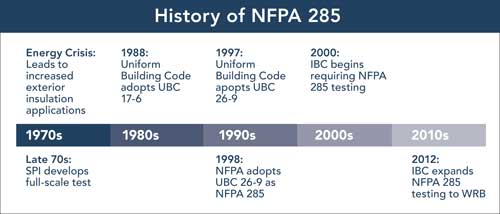Navigating Wall Assembly Fire Testing
Not willing to give up so quickly, the Society of the Plastics Industry (SPI) sat down with code and fire officials and asked what it would take to convince them that putting foam insulation in the walls would not present a fire hazard. The officials then responded with a challenge.
“The plastics group was charged to design a test which would show that if a wall was fully burning, that the flames would not travel a significant distance, vertically or laterally, because of the foam plastic,” explains Jesse J. Beitel, a senior scientist/principal with the Baltimore-based fire protection engineering and code consulting firm Hughes Associates. “That's how the first, two-story outdoor test was developed, but it still took another eight years before the codes adopted it.”
 |
From its official adoption to the Uniform Building Code in 1988 to the 2012 International Building Code, fire testing is required for combustible components in wall assemblies. Source: DuPont Building Innovations |
Finally, in 1988, the Uniform Building Code (UBC) adopted the test method and allowed the use of foam plastics on the exterior walls of all construction types based upon the successful performance of several foam plastic insulated wall systems.
“However, it was an expensive test, plus one was at the mercy of the weather, so the plastics industry went about reducing the scale of the test and moving it indoors,” he continues. “That test was then adopted in the UBC in 1992.”
The test was then submitted to the NFPA Committee on Fire Tests and, in 1998, was published as the NFPA 285 fire test method that is used today.
Beyond Foam Plastic
While the original push was to include foam plastic insulation in exterior walls, more recently, combustible exterior claddings and water-resistive barriers (WRB) have been incorporated into the codes. In particular, the International Building Code included exterior insulation finishing systems (EIFS) in 2000, metal composite materials (MCM) in 2003, fiber-reinforced plastics (FRP) in 2009, and high-pressure laminates (HPL) in 2012, as combustible components within noncombustible wall assemblies requiring NFPA 285 testing.
Also, in 2012, the IBC added WRBs as components requiring testing before their use would be permitted in Type I, II, III, and IV buildings over 40 feet above grade (see sidebar “International Building Code Construction Categories” on the next page). This provision was recently added in as testing discovered that assemblies which passed NFPA 285, later failed with the addition of a WRB.









